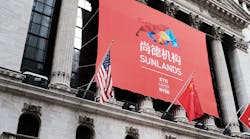The U.S. proposed imposing 25% tariffs on about $50 billion worth of Chinese-made products, focusing on high-tech items from semiconductors to lithium batteries. China condemned the move and said it will respond on an equal scale against U.S. products.
“This level is appropriate both in light of the estimated harm to the U.S. economy, and to obtain elimination of China’s harmful acts, policies, and practices,” the U.S. Trade Representative’s office said in a report on Tuesday. The U.S. is targeting the 1,300 product lines to try to force China to change its intellectual property practices, the office said.
In deciding which products to hit, U.S. officials identified items that “benefit from Chinese industrial policies, including Made in China 2025,” USTR said, referring to Beijing’s plan to dominate key strategic technologies. The U.S. also picked products based on the principle of trying to minimize the effect on the U.S. economy and consumers, the office said.
In addition to advanced technologies such as communication satellites, the list includes products ranging from various types of steel to television components, medical devices, dishwashers, snow blowers and flame throwers. The proposed tariffs cover a number of sectors, from health care to aviation and auto parts.
Asian stocks were mixed at the open as traders awaited a more detailed response from China to the latest step in an escalation of trade tensions between the world’s two biggest economies.
China’s Ministry of Commerce condemned the proposed U.S. tariffs and said the nation is ready to take measures against U.S. products with the same intensity and scale.
"China plans to immediately bring relevant U.S. practice to the dispute settlement body of the WTO, and is ready to take counter measures on U.S. products with the same intensity and scale that will be published in the coming days," the Ministry of Commerce said in a statement Wednesday.
Strong Response
The U.S. duties will likely provoke a strong response from China, said Carlos Gutierrez, U.S. commerce secretary under former President George W. Bush.
“Wars start with battles, and the battles have started,” Gutierrez, co-chair of the consulting firm Albright Stonebridge Group, said in an interview in Mexico City. Chinese President Xi Jinping “can’t afford to look like he’s getting pushed around.”
The U.S. list appears to be more “bellicose” than the range of tariffs China announced Monday in response to separate American duties on steel and aluminum imports, said Mark Muro, senior fellow at the Brookings Institution. They included tariffs of as high as 25% on more than 120 items such as U.S.-supplied pork and sparkling wine.
What our economists say ...
"The U.S. proposal on tariffs aims to hit China’s industrial ambitions without hurting U.S. consumers," said Tom Orlik, chief Asia economist at Bloomberg Economics in Beijing. "On both objectives, it will likely fall short. In sum – we think the macro impact will be limited and the strategic objectives difficult to achieve."The release of the list by U.S. Trade Representative Robert Lighthizer leads into a roughly 60-day period when the public can provide feedback and the government holds hearings on the tariffs. The 25% tariffs comes on top of any existing levies.
Some business groups immediately denounced the proposed tariffs. “The administration is rightly focused on restoring equity and fairness in our trade relationship with China. However, imposing taxes on products used daily by American consumers and job creators is not the way to achieve those ends,” said Myron Brilliant, head of international affairs at the U.S. Chamber of Commerce.
An organization representing U.S. technology companies including Amazon.com Inc. and Intel Corp. urged the Trump administration to work with other countries to “address systemic issues with China.”
“If history is any indication, these proposed tariffs will not work and will be entirely counterproductive,” said Dean Garfield, chief executive officer of the Information Technology Industry Council. “Tariffs penalize U.S. consumers by increasing prices on technology products and will not change China’s behavior.”
The National Retail Foundation said it was pleased products such as shoes and clothing were excluded, but it expressed concern at proposed duties on consumer electronics and household appliances.
However, a group representing manufacturers and steelworkers applauded the move. “The administration’s proposed actions will help restore some balance with China, as well as recreate an environment where some of the millions of jobs we’ve lost to China will have a chance of being restored,” said Scott Paul, president of the Alliance for American Manufacturing.
Penalizing Beijing
Trump said on March 22 the tariffs were aimed at penalizing Beijing for what the U.S. alleges to be theft of American companies’ intellectual property. The president’s recent trade actions, which also include duties on steel and aluminum, have provoked concerns of a global trade war. China imposed tariffs of its own in response to Trump’s actions on metal imports.
China’s Made in China 2025 plan was announced in 2015, and highlighted 10 sectors for support on the way to China becoming an advanced manufacturing power, from information technology, to robotics and aerospace. In addition, China has a separate development strategy for artificial intelligence, published in 2017.
USTR said the public can submit written comments on the tariffs until May 11, and it will hold a public hearing on them on May 15 in Washington.
by Andrew Mayeda, Miao Han and Kevin Hamlin




